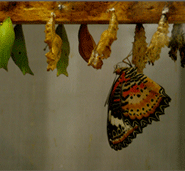Editor's Note.
Every sunbeam, every strain of music, every sapling and starfish is ultimately the regeneration of a previous something, a collection of somethings, taking on new shape. At the most indivisible level we can comprehend, all life is nothing more than atoms and molecules dancing their way through various forms. And if everything comes from something, it stands to reason that everything must go to something as well.
Read MoreThe Prophet as Artist.
By Manjari Kaul, Issue 25, Meaning: In Search of Significance.
In the everyday experience of the artist there is no foretelling the impetus of inspiration. Often at unlikely junctures, in slumber land or trite situations, there is a flash of lightening, lyrical illusion or poetic vision that joins the dots between past and present, projecting itself onto the future like a prophecy.
A Cosmic Amplitude: CAMP
By Meara Sharma and Henry Peck, Issue 22, Inertia: Being Both At Once.
Imbued with seemingly endless possibilities, the name CAMP comes to mean nothing. Or rather, it means everything. CAMP resists inertia (instead, it aspires toward infinity)...
Raqs Media Collective: On Triangles, Infinity and Learning Where to Stop.
Issue 16,The End is Where We Start from II, January 2013
The Raqs Media Collective is most often a triangle, sometimes a circle and often a shape elusive to geometry, a bubble, a building, a boat. In being, they create. In creating, they think and ...
The Ghosts of Industry.
By Angela Jane Evancie, Issue 14, The Non-Fiction Issue, October 2012
This was a place for machines, once; empty now, the inhuman scale of the walls and ceilings shrunk us to almost nothing.
Resurrection: Sheba Karim and the intentions of history.
By Sheba Karim, Issue 14, The Non-Fiction Issue, October 2012
In my research for Razia, the ‘truth is stranger than fiction’ adage often comes to mind. There was a lot of madness in medieval India! Truth, of course, is never limited by possibilities. If something is ‘true,’ then people immediately suspend disbelief—if it’s actually happened, what is there not to believe?
Something Not Exclusively Art.
By Anirudh Karnick, Issue 14, The Non-Fiction Issue, October 2012
In the debate between art for art's sake and art with a (sociopolitical) purpose, what is ignored is that most people to whom art (in any form) matters use it for 'life's sake'.
On the off-Chance.
By Himraj Soin, Issue 12, The Chance Issue, September 2012
Himraj Soin utilizes the idea of imitation and improvisation by redrawing five Calvin and Hobbes comic strips, and is therefore fated to be a mere imitator. What happens to the artist when he has no free will?
Art words we love to hate (and still use anyway)
By Avni Doshi, Issue 11, Beauty And The Useless, September 2012
Avni Doshi, in truly "meta" form, parodies the words you'll eavesdrop on, or worse, have to endure directly, at an art opening or a 'salon'.
Fonting By Hand.
By Waylon D’Mello, Issue 7, Text Art, April 2012
“Penmanship says a lot about your character,” my teacher’s voice reverberated in my ears as I learnt the regimen of curly bumps, pointy cones, unbroken tsunami wave patterns, and of course, the standard cursive.
An ordinary encounter with the Extra Ordinary.
By Parni Ray, Issue 7, Text Art, April 2012
Calm yet vocal, sentimental yet witty, Hema’s Extra Ordinary is likely to linger in your mind and remind you of the essentially fragmented nature of everyday city life and your own multiple selves, perspectives, disorders
Illusion: Seeing Beyond Seeing
Meaning: In Search of Significance.
Melody: A Different Tune
Rhythm: Ordering Time












